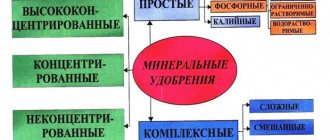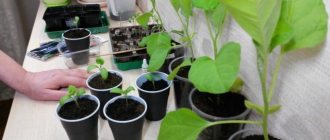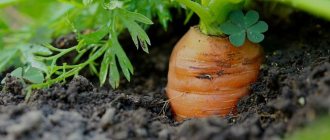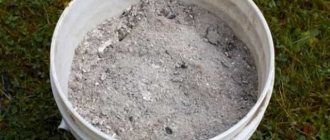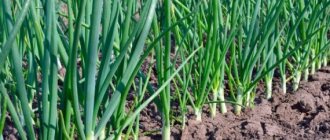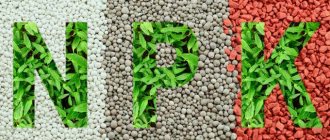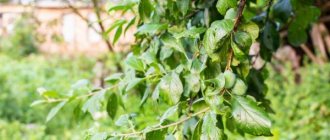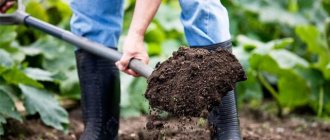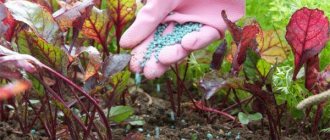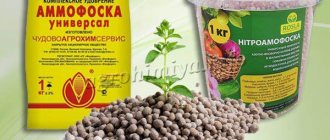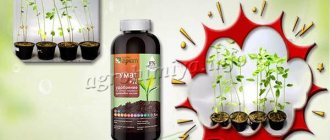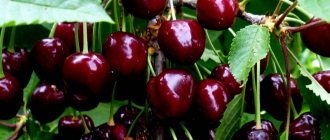The benefits and harms of using mineral fertilizers in the garden
From the 9th grade chemistry textbook we know that all living matter needs minerals, on which the quality of life of plants and humans directly depends. Mineral fertilizers are the main source of useful microelements when fertilizing in gardening and horticulture.
The method of influence depends on the composition of the selected drug; a special classification of fertilizers has been developed for this purpose. Practical work to determine the type of impact and the expected positive results has made it possible to identify combinations of the most useful minerals, but not every drug does not fully contain all of the listed benefits.
Mineral fertilizers in the garden and vegetable garden
What are the benefits of complex mineral fertilizer:
- accelerates plant development, ensuring better growth and formation of greenery;
- improves the quality of absorption of beneficial microcomponents from the soil;
- restores the quality of soil composition, this improves fertility characteristics;
- increases crop yield, sometimes efficiency indicators reach 50%;
- enriches the taste of fruits;
- stimulates the production of more vitamins in ripe vegetables and fruits;
- prevents the onset of diseases and the appearance of various pests;
- allows you to shorten the process of waiting for growth and helps you get 2 harvests per season;
- restores plants after various stresses: drought, frost, rainy season, etc.;
- provides an attractive presentation, the products become smooth and beautiful;
- acts as a stimulant for flower set.
At first glance, beneficial properties led to negative aspects. Today you can buy mineral fertilizer in any corner of the world at a low cost and use it at your discretion. After the advent of freely available fertilizers, due to incorrectly chosen doses of drugs, many negative effects on the state of nature appeared:
- deterioration of the quality of local ponds and underground rivers. Nitrogen and phosphorus are washed out of the soil and end up in the stakes. They start the process of active growth of algae, which, after dying, release methane and pollute the reservoir. This causes the fish to grow smaller, die early, and if consumed frequently can cause stomach problems;
Mineral fertilizers accelerate plant development
- phosphating and salinization of the soil often leads to erosion and loss of the proper level of fertility;
- the environment is clogged with nitrate, chloride and other compounds;
- acidified soils require time to restore the correct acid-base balance. When acid is released, acid rain can occur.
What is the difference between organic and chemical fertilizers?
Paradoxically, the difference between chemical and organic fertilizers lies not in environmental friendliness or benefits, but in the speed with which they are absorbed by plants. Organic matter first needs to decompose, only then can crops absorb the substances they need. The process of releasing beneficial elements from it after fertilizing the soil takes from several weeks to several months.
From mineral fertilizers, plants receive the substances they need in a form that is already free for absorption. This has a positive effect on crop resistance to diseases, their growth rate and productivity. In addition, fertilizers produced in Russia are tested for safety for human health, animals, and nature. Their environmental cleanliness is regulated by technical specifications and state standards.
Types of mineral fertilizers
The type of impact and expected benefit directly depend on the type of fertilizer. There are 4 main groups of mineral fertilizers:
- nitrogen – ensure acceleration of plant development;
- phosphorus additives accelerate the growth of rhizomes, the components also provide resistance to various diseases;
- potassium Their use leads to an increase in the amount of vitamins in the soil and fruits;
- complex mineral fertilizer. At the same time, fertilizing with potassium, nitrogen and phosphorus or several of the above options is carried out.
Types of fertilizers and their classification allow you to determine the appropriate types of substances for the soil in a region or a specific area. Their types and characteristics can be combined into complex fertilizer options. To determine mineral fertilizers that are suitable in composition, soil chemical tests should be carried out. Without special instruments, it is possible to determine the deficiency of certain components based on the state of the vegetation.
"Superphosphate", phosphate fertilizer
Classification of mineral fertilizers with examples of common products in each category:
- nitrogen: urea and ammonium nitrate;
- phosphorus fertilizers: “Superphosphate”, “Potassium flour”, calcium monohydrogen phosphate;
- potassium fertilizers: potassium nitrate, potassium chloride, “Kalimagnesia”;
- complex options are the main types of mineral fertilizers used in Russia, there are a large number of them. Among the most popular: “Ammofos”, “Nitrophos”, “Nitrophoska”, “Diammofoska”, etc.
Fertilizers can be classified according to other criteria (efficiency, amount of the main component, simplicity of the chemical composition, etc.). Even in schools there is practical work: “Identification of mineral fertilizers,” which can be useful for future gardeners.
What is fertilizer
These are substances of mineral or organic origin intended to increase soil fertility and plant nutrition.
The safest fertilizer is considered organic - peat, manure, compost. But these natural products take up a lot of space. Therefore, mineral fertilizers, which are sold in granular, powder form, do not lose popularity. The most common chemical complexes among gardeners and gardeners contain nitrogen, calcium, and phosphorus.
The theory that nitrogen-containing compounds stimulate plant growth, and phosphorus-containing compounds strengthen the root system, is perceived as an indisputable fact. This belief arose due to the massive use of minerals in industrial agricultural production. Is it really necessary to apply them on personal plots? An American specialist calls the established rules about feeding plants myths and tries to debunk them.
Complex mineral fertilizers
Now we will take a closer look at the production of mineral fertilizers in Russia, which are of the complex type with complex compositions. Chemical fertilizers can restore the plant even after severe stress and ensure the full quality of development and fruiting.
The production of mineral fertilizers in Russia places an emphasis on complex options due to the achievement of the greatest effect. The products of domestic enterprises are in demand among buyers due to the low cost of goods and high quality of products. Next, preparations related to mineral fertilizers are subject to consideration.
"Ammophos" is a universal chemical fertilizer
"Ammophos"
The product is based on phosphorus (about 50%), nitrogen and potassium - these are all the key ingredients of a complete fertilizer. “Ammophos” differs from its analogues in that it can be used in closed ground and greenhouses, since most other fertilizers are used exclusively in open fields. An additional useful property is the presence of sulfur in the composition; it is extremely useful, but is rarely found in mineral complexes. The key advantage is the absence of dangerous chlorine and sodium compounds.
The production of mineral fertilizers in Russia is largely represented by Ammophos, produced in the form of small light granules. The substance is quite crumbly and can be easily used by amateur gardeners. A special feature is the tendency to uniformly mix the composition.
"Ammophos" is a universal chemical fertilizer that shows high efficiency results in relation to flowers. When using a rose fertilizer, the flowers respond with abundant and lush color, and the number of buds also increases.
"Diammofoska"
"Diammofoska" is a representative of complex fertilizers, which consists of all the most important elements for feeding vegetation. The composition contains nitrogen, phosphorus and potassium. Can be used regardless of soil type and crop.
The drug is sold in granular form with a pink tint of the substance. The top is treated with anti-dust reagents, which ensure friability and easy solubility in water. Thanks to the neutral pH, the soil does not become acidified.
"Diammofoska" is a representative of complex fertilizers
The plant does not fully absorb the fertilizer and partially remains in the soil. There is no leaching of the substance from the soil. The drug will be processed by subsequent plants, that is, the effect has a long-term effectiveness. Can be used for processing seed material, for applying root and foliar fertilizers.
The substance has an optimal effect on tomatoes during the period of color release. The action of the drug provides resistance to pests and improves the quality of absorption of beneficial components from the soil.
"Nitroammofoska"
The product contains large amounts of phosphorus, nitrogen and potassium in various proportions. “Nitroammfoska” (also known as “Azofoska”) is used for fertilizing vegetable and horticultural crops, as well as in the agricultural industry.
Production allows you to obtain many brands of fertilizer, the most popular is: 16:16:16.
The greatest efficiency of use is observed on chernozem, chestnut and sierozem soils. It is one of the best fertilizers for use in loamy soils. The optimal result occurs when applying the product to clay soils, where a slow diffusion process is observed in the fall. It is added to sandstones in the spring before digging.
"Nitroammofoska" contains a large amount of phosphorus, nitrogen and potassium
"Nitrophoska"
The drug consists of 3 elements N+P+K. “Niktrofoska” is used for feeding most crops in the garden. “Nitrophoska” is based on salts of superphosphate, potassium nitrate, ammophos, gypsum, ammonium chloride and other impurities. It is produced in the form of small peas, easily soluble in liquid.
Refers to complete mineral-type preparations that are used for sowing in the spring and during the development of greenery. The use of "Nitrophoska" is available for all categories of agriculture and agro-industrial sphere. It is preferable for them to fertilize tomatoes, as the fruits increase in size and become sweeter, and cucumbers - they become more resistant to various diseases.
Do you use folk signs in gardening?
The product can be used to fertilize the entire area or to add to the bushes; the effectiveness of the chosen method is not reduced. In the case of potatoes, you should prefer a form of the compound without chlorine. Potato plantings respond better to “Nitrophoska” than to “Nitroammofoska”. The tubers grow larger and the entire area is resistant to various dangerous diseases.
What types of organic fertilizers are there?
Organic fertilizers contain only natural ingredients, which increases their value for agricultural crops and indoor plants. All types of organic fertilizers are in harmonious interaction with the soil, enriching it with beneficial microorganisms and nutritional components. Organic matter has a beneficial effect on the development and active growth of plants and helps improve productivity.
Cow dung
One of the most common types of organic matter is cow manure. It is not difficult to purchase this fertilizer; it is freely sold in farms and private households. Almost every gardener knows about the benefits of mullein:
- it actively improves the structural composition of the soil;
- increases soil breathability;
- restores and improves moisture capacity;
- saturates the soil with nutrients.
But mullein cannot be used indiscriminately. Otherwise, instead of being useful, cow dung will ruin the structure of the soil.
Application tips
- Cow dung is applied in the form of fertilizer to the soil once every 4 years. Optimal dosage per sq. m. soil - up to 4 kg. If the soil has a poor composition or crops have not been planted on it for some time, then it is allowed per square meter. m. add up to 6 kg of soil. mullein
- It is not always possible to use fresh mullein. Fresh mullein may contain parasites, weed seeds, foreign objects and everything that the esophagus has not processed. Fresh manure produces large amounts of heat and gas. Plants surrounded by additional heat actively grow and elongate, but become weak and unable to bear fruit well.
- An excess of manure in the soil negatively affects its structural composition and, accordingly, the quality of agricultural crops.
- It is best to introduce mullein into the soil in the fall during the mandatory digging of the site.
- Mullein cannot be used on acidic soils, as it further acidifies the soil composition. In this option, it is better to use horse manure or a mixture of mullein and horse droppings.
- Cow manure should be introduced into planting holes as carefully as possible. Direct interaction of fresh organic matter with the root system of agricultural crops can result in burns for the latter.
Chicken droppings
In terms of nutritional value, chicken manure can easily be compared with complex mineral supplements. Bird droppings are rich in nitrogen, phosphorus, magnesium, and potassium. One of the most valuable components of chicken manure is bacteriophages, which contribute to fertilization, disinfection of the soil and free it from pathogenic infections and harmful microorganisms.
How to use
Chicken manure, like any other type of organic matter, should not be used indiscriminately.
- Poultry droppings contain a high content of urea. It is impossible to use manure in its pure form, as this can cause burns to the root system of agricultural crops. Bird droppings are used as part of compost, peat or soil (ratio 1:2).
- For agricultural crops, it is best to use an infusion of organic fertilizer. It is prepared by mixing 20 liters. water and 1 kg. litter After infusion for 10 days, the fertilizer is ready for use. Fertilizing the soil with infusion of chicken manure is done only after preliminary moistening of the soil. The infusion is applied between rows.
- Chicken manure is added every 2-3 years. The rate of fertilizing is per square meter. m. soil up to 1.5 kg. organics.
Compost
Compost is an excellent substitute for cow dung. The chemical composition of this fertilizer contains an active set of micronutrients necessary for agricultural crops - potassium, phosphorus, sodium, nitrogen.
Compost has the following beneficial qualities:
- increases the enzymatic properties of the soil;
- improves the nitrogen-fixing properties of the soil;
- improves the structural composition of a favorable environment for beneficial microorganisms living in the soil.
Features of application
- Unripe compost is dangerous for agricultural crops. It contains pathogenic microorganisms, weed seed residues, and harmful substances. But semi-ripe compost is ideal as mulch. It can also serve as an excellent fertilizer for young crops.
- Compost from the first year of life contains high levels of nitrogen. If you fertilize the beds with young compost, then for 1-2 years crops that have the ability to actively absorb nitrates cannot be planted in this place. Such crops include radishes, beets, spinach, and lettuce. But it is recommended to plant such crops as cucumbers, tomatoes, eggplants, pumpkin, and cabbage of all varieties on the beds fertilized with compost from the first year of life.
- The chemical composition of compost does not contain a sufficient amount of magnesium and potassium, therefore, when adding this type of organic matter, it is recommended to alternate fertilizers based on these mineral compounds.
- And the most important point is that compost is an ideal breeding ground for such a well-known pest as the mole cricket. If compost is purchased from neighbors, then it is important to be sure that the organic matter does not contain pest larvae. To protect your garden from annoying insects, it is recommended to prepare compost yourself.
Making compost from manure
- Prepare a compost pit (if you plan to prepare a small amount, you can use an iron barrel).
- The first layer should be plant material - fallen leaves, weed residues, agricultural tops, etc.
- Then a layer of soil and manure is laid out on the plant layer (ratio: 2 parts of plant material and 1 each of soil and manure).
- Pour warm water over the mixture.
- Cover the compost pit with a wooden lid.
- Leave to mature for 7 months or more.
Preparation of compost from plant materials
- Mix manure with soil and peat (in a ratio of 5:1:1).
- Transfer the resulting mixture to a pre-prepared compost pit.
- Sprinkle the mixture with plenty of water.
- Leave to mature for 6 months.
The longer the compost rots in the pit, the more nutrients are formed in its composition that are useful for the active growth and rich fruiting of agricultural crops.
Peat
Compared to other types of organic fertilizers, peat is not used as often. But in vain. Peat has the following properties beneficial to the soil:
- loosens;
- increases breathability;
- improves water absorption.
Peat does not contain microelements useful for agricultural crops, so it is recommended to use it in combination with other types of organic matter. It is ideal to prepare peat-based compost. At the same time, it alternates layers with plant raw materials in the compost pit.
Experienced gardeners warn that adding peat to the soil fresh can be dangerous for plants. The fresh product contains elements such as iron and aluminum, which contribute to soil acidification.
Before adding peat to acidic soils, it is necessary to carry out a process of deoxidation.
Methods:
- peat + ash (for 100 kg of peat take 10 kg of ash);
- peat + dolomite flour (for 100 kg of peat, take 5 kg of dolomite flour);
- peat + lime (for 100 kg of peat, take 5 kg of lime).
The rate of application of organic fertilizer is per square meter. m. soil up to 8 kg. active composition.
It is necessary to introduce peat into the soil in the deep soil layer (on the bayonet of a shovel). It is convenient to fertilize the soil during autumn or spring digging.
Peat happens:
- Lowland.
- Intermediate.
- Horse.
Lowland and intermediate types of peat can be used as top dressing. The upright species is suitable only for use as mulch and covering plant material for wintering plants.
Ash
The use of ash as a fertilizer is popular among gardeners and flower growers. Ash is a good fertilizer for indoor flowers. This product saturates the soil with useful substances - phosphorus, magnesium, boron, iron, molybdenum, manganese and many others. The only thing that ash does not contain is nitrogen.
What do you need to know when using ash as an organic fertilizer?
- The application of ash must be alternated with the use of nitrogen-containing fertilizers. But it is impossible to use 2 active types of fertilizers at the same time, otherwise the constituent elements of the ash will enter into a chemical reaction with nitrogen, and this will result in the release of ammonia, which is harmful to all agricultural crops.
- It is best to use ash on acidic soils. But you need to be careful when introducing the product into soil that has a neutral or alkaline composition. One of the qualities of ash is the ability to deoxidize the soil, which can negatively affect the development of agricultural crops.
- Ash can be stored for up to 2 years. But in order for the fertilizer not to lose its beneficial qualities, it must be reliably protected from moisture during storage. Even slight moistening of the ash negatively affects its composition, as a result it becomes absolutely useless for garden and indoor plants.
- There are also recommendations on the time of adding ash to the soil. If you plan to fertilize loamy and clayey soils, then it is best to apply organic matter in the fall. In the case of feeding peat and sandy loam soils, organic matter is added in early spring.
- Beginning gardeners often make the mistake of adding ash while deep digging the soil. But the best use of fertilizer is to apply a small amount of ash powder directly into the planting holes. Another option for fertilizing the soil is to spread a thin layer of ash over the top layer of soil (without digging). A good fertilizer option is to prepare an ash solution (take 1 tbsp of active ingredient per 10 liters of liquid).
- Feeding young seedlings with ash should be done when 3 true leaves appear on the plants. It is also important to know that some agricultural crops do not tolerate fertilizing in the form of ash (radish).
Sawdust
An equally popular type of organic fertilizer is sawdust. But it must be used very carefully.
The fresher the sawdust, the more harmful it is to agricultural crops. Young sawdust introduced into the soil will “draw in” nitrogen and moisture, and accordingly, the plants will begin to experience a deficiency of these beneficial substances.
Sawdust is recommended to be used as mulch. For this, it is best to use a rotted product. Mixing sawdust and urea is allowed (in the ratio of 3 buckets of sawdust to 1 tbsp. urea).
Another feature of using sawdust is that it can acidify the soil, so it must be applied carefully to acidic soils. To deoxidize organic matter, it must first be limed before adding it to the soil.
Green manure
Beneficial properties of green manure crops:
- enrichment of soil with main mineral components;
- improvement of soil structure;
- prevention of weed spread;
- attracting earthworms;
- protection of the upper soil layers from blowing away nutrients;
- prevention of soil erosion.
Features of green manure:
- The best period for cutting green manure crops is the moment of budding.
- After cutting, the green mass is laid out on the surface of the bed as a mulch layer. Green mulch retains moisture, creates an ideal environment for the successful development of microorganisms beneficial to plants, stops the spread of weeds, and helps make the top layer of soil loose.
- The root system of green manure remaining in the soil improves the structure of deep soil layers.
Bone flour
Bone meal is used to activate the growth of agricultural crops. Phosphorus and calcium predominate in significant proportions in organic fertilizer.
The rate of adding bone meal to the soil is per square meter. m of soil up to 3 kg. active product.
Another way to use organic fertilizer is to prepare an aqueous solution. To obtain a nutrient mixture, 20 liters are required. Dissolve 1 kg of boiling water. powdered bone meal. Mix the mixture thoroughly and leave to infuse for 7 days. Periodically, the solution needs to be stirred with a wooden stick. Before use, the concentrated solution must be mixed with water in a ratio of 1:10.
It is useful to feed agricultural crops with a bone meal solution once a month. The same composition can be used to feed indoor plants.
Nitrogen fertilizers
The main advantage of using nitrogen fertilizers is their good diffuse properties; accordingly, the substances are perfectly soluble in liquid. You can use them to prepare liquid mineral fertilizers; some stores sell already prepared liquids.
Most often, fertilizers are introduced in early spring, 1 month before digging. This is done to ensure sufficient release of essential microelements before planting. Conditions for each drug may vary.
Nitrogen fertilizers contain the most important microelements for planting
Potash fertilizers
Potassium sulfate
More often called potassium sulfate. With an abundant content of the component in the soil and fertilizer, it is possible to cover the deficiency in vitamin K. The composition does not contain impurities that can harm the condition of plants (magnesium, chlorine, sodium and others).
It is often used to fertilize cucumbers at the moment when the ovaries appear and at the beginning of fruit ripening. Cucumbers love potassium, and the product contains up to 46% of this substance.
The drug is applied when digging in the spring at a dosage of 25–30 g per m2, and when root feeding - 10 g/m2.
Potassium salt
The product is based on 2 key elements, both belong to the chloride group. Appearance – dark color, similar to rust, sold in granules. The most successful form of the substance is “Sulvinite”, and it is most often used.
Salt is applied in the spring under various berry bushes based on a dosage of 20 g per 1 seedling. Before plowing, it is added to the soil in the autumn. For a continuous scattering of the substance, a dosage of 150–200 g/m2 should be used.
Fertilizer "Potassium salt"
Potassium chloride
The product contains the largest amount of potassium of the presented options, the dosage is 50%. It is used in the autumn before plowing. 20–25 g of the drug is used per 1 m2. After fertilizing, you need to flood the area well or wait for rain, then the chlorine from the composition will go down and will not harm the plants.
High efficiency is noted for beets, cereals, potatoes and barley. Potassium chloride is a salt of hydrochloric acid; its use in large concentrations can worsen the condition of the soil.
It is used at approximately the same dose for all crops – 200 kg/ha. In the case of fertilizing crops that should contain large amounts of sugar, the amount of the drug should be increased by 25–50%.
Myth #2: Roses need phosphorus to grow and bloom well.
Statement
Many gardeners advise adding a staggering amount of “chemicals” when planting roses: superphosphate, phosphorite, and triple superphosphate. Sometimes it is also advised to “flavor” the soil with bone meal and manure. The American specialist decided to figure out how justified the use of such an “explosive mixture” is.
Reality
The American admits that she carefully studied the research on the effect of phosphorus on the flowering and root formation of roses and did not find any compelling arguments in favor of phosphorus fertilizing when planting seedlings of this crop.
Why is a myth dangerous?
Numerous scientific works and experiments have proven the presence of symbiosis between roses and beneficial fungi. By applying phosphorus fertilizers, you prevent the fungus from “colonizing” the root system of roses. As a result, it is much more difficult for plants to extract water and nutrients from the soil.
In addition, soil “contamination” with minerals kills beneficial microorganisms and reduces biological activity in the soil.
As a result, roses grow worse and get sick more often, which forces inexperienced rose growers to carry out additional feeding.
Alternative
Do not apply phosphorus fertilizers when planting rose seedlings . The soil in a summer cottage is extremely rarely deficient in this element. It is preferable to feed roses with complex fertilizers and organic matter.
Phosphorus fertilizers
Double superphosphate
It is in demand due to the large number of useful microelements in the composition; this is achieved by isolating useless microelements from the formula. The drug is produced in different regions, which is why the effectiveness of use differs. The dosage of phosphorus is in the range of 32–47%.
The product is optimally suited for flower crops. Often used for roses that are preparing for winter, then the plant tolerates cold better.
Fertilizer with high phosphorus content Double superphosphate
Phosphorite flour
The use of the product is indicated for soil oxidation. Suitable for use on all crops. After applying fertilizing, plants become more resistant to diseases, as their own immunity is stimulated. The product improves the tolerance of winter cold in most plants.
Phosphorus in flour contains from 19%. It also contains a large amount of calcium, its concentration reaches 35%. It is applied at a ratio of 300–350 kg/ha.
Myth No. 4: Foliar fertilizing is more effective than root fertilizing.
Statement
Quite often you can hear gardeners singing odes to foliar feeding. Manufacturers of liquid complexes especially like to advertise this method of fertilizing. Proponents of spraying plants with essential nutrients claim that the aboveground part of the plant absorbs them much faster.
On the packaging of some liquid fertilizers you can even read bold statements that substances applied by foliar feeding are absorbed 8, 10, or even 20 times better than with traditional root watering. Believe it or not?
Reality
Linda Chocker-Scott cites a Michigan State University study conducted in the 1950s by Dr. Tukey. Using an isotopic substance, the scientist was able to prove that the plant leaf is able to effectively absorb nutrients. Yes, not in such large volumes as roots, but still very effective.
Does this mean that it makes sense for all agronomists to switch exclusively to foliar feeding? Of course not! The fact is that the ability to absorb nutrients and moisture through the leaf plate is individual and differs in different plant species. Most often, this method is effective in mass commercial cultivation of fruit crops.
Let us repeat that foliar feeding is good as a test of the condition of the plant. If, based on external signs, you have come to the conclusion that the plant lacks, for example, calcium, first try spraying the leaves with it. If the symptoms of element deficiency have passed or decreased, then the assumption was correct, and you can introduce the deficient element into the soil without fear of causing an imbalance in its composition.
Why is a myth dangerous?
The first possible negative effect of this agricultural technology is obvious: by fanatically spraying a crop that does not respond well to foliar feeding, you risk starving it.
The second risk is the wrong choice of fertilizer concentration. The slightest mistake and you can simply burn the plant, especially when it comes to feeding with minerals.
The third nuance is that the fertilizer will be successfully absorbed by the leaves, but the nutrients will not reach all parts of the plant. This means that foliar feeding will not solve the problem of nutrient deficiency in the root system.
Alternative
- Before fertilizing, carefully study the information about the susceptibility of plants on your site to foliar fertilizing .
- Don't rely on spraying fertilizer as a reliable way to provide your plants with all the nutrients they need. Use foliar feeding as a test for elemental deficiencies .
- It is preferable to spray plants with microelements . They are absorbed through the leaves better than macronutrients.
- Spray plants in the morning and, if possible, on cloudy, cloudy days. This will reduce the risk of burning the leaf plate.
Complex-mixed
Mostly complex mixed types are liquid or powdered mineral fertilizers, which are obtained by combining several simple components in powder form. Then a solution of ammonia, sulfur or nitrogen is added. The most widely used options are those with ammonium nitrate, phosphates and potassium chloride.
Complex mixed types are similar in composition to complex fertilizers, and their cost is approximately identical. The most expensive options contain superphosphate. The method has several advantages:
- you can prepare various mixtures of substances;
- mixing can be done anywhere;
- the formula of the substance is selected for different types of soil;
- wide possibilities of use.
Complex mixed types include compositions of nitrophos and nitrophos, which are mined in the process of transforming phosphorite or apatite. They are used before sowing and are also placed in holes.
Complex mixed types of fertilizer
During the manipulations, carbonammophos is obtained, which is a compound of nitrogen and ammonia. The use of these substances is relevant in large enterprises that need to process large areas of land.
